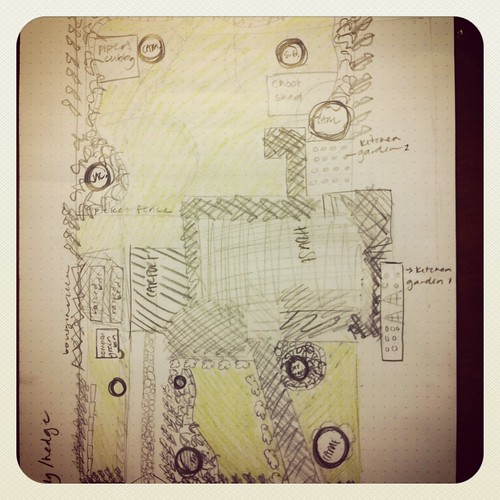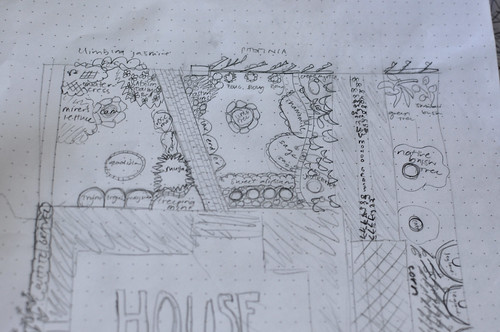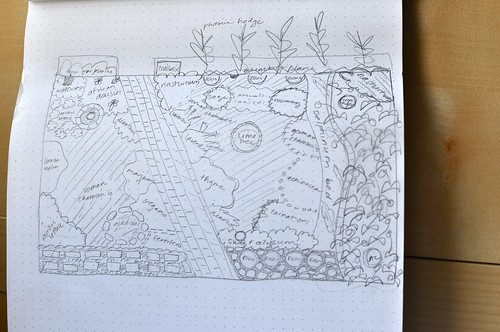Seeds and starting out.
 Saturday, October 13, 2012 at 11:29AM
Saturday, October 13, 2012 at 11:29AM The why of gardening.
I think I garden for selfish reasons. Even though I am community-minded, and I love my family, there is nothing better than growing food for yourself, by yourself. I like to be independent, and not having to go further than my backyard to grab dinner sounds bloody brilliant. Let's face it: I'm busy, and though I'm not lazy, I really really want to be. So gardening is work that yields a fantastic reward; I don't have to go to the grocery store and pay them for their crappy fruit and veg. Also, I can get food for dinner in my pajamas. BONUS.
I'm more of a "plant it and let it grow" type of person (aka lazy gardener), which is why initially when we cut down and poisoned (grr, so frustrated, but it's so unavoiable) all of the privet, it irritated me to see stumps. I'd rather have trees, but here, privet is a noxious weed that can choke a backyard in a few short years. The other reason we went "scorched earth" is because I want to grow vegetables, and you need sun for that. We are also affected by a storm drain easement, which inconveniences me because it means there's a 2m long strip of my yard I basically can't build any structures on, like raised beds, or garages, or any of that. It's totally sunny, but no planting (other than grass or a similar grouncover). So we got rid of the privet, cleared the area where our shed and herbs will go, and have built three of the four (or five!) beds needed to get our garden started properly. There is enough sun now, and I have started my seeds inside.
The what of gardening.
I love growing from seed, so I usually order seed catalogues and pick out plants from there. I get that online ordering is great, but there is something about opening a newsprint-smelling booklet and poring over the seed description. One description I read today said it "gladdens the heart." Yes, please! Despite loving printed catalogues, I always order online from my favorite retailers. They are prompt, have a good selection, and, most importantly, they are majority heritage, heirloom, or rare seeds.
These are my favorites:
Green Harvest - my most trusted and reliable source. Always prompt and always friendly. Heaps of organic seeds, poultry forage, green manure, and lots of tropical friendly plants for eating. Also a great "toolshed" and book shop.
Eden Seeds - a beautiful catalogue and lots of interesting flowers/herbs as well as veg! Good selection of books, and they do sell in bulk for farmers.
The Lost Seed - they have lots of rare, heirloom, in-need-of-seed-saving seeds. Cheap and quick and wonderful selection.
Greenpatch Seeds - organic seeds and lots of different and interesting varieties!
I do not belong to Diggers, though I have heard good things, mostly because I don't think the benefit would outweigh the cost. When we move to Tasmania and retire to our tree-change, I think that's when I'd join, but for now, with only 1/6th an acre, I'm happy with littler seed companies. And the above four give me plenty of selection of rare, non-hybrid varieties.
Of course, if I'm at Bunnings, I can't go past Mr Fothergill's Seeds just for a squiz. I have also been given a few packs of Johnson's Seeds, and I do plant with Yates, usually bought at garden stores (like Sherringham's Nursery or Eden Gardens), but there I tend to grab flower seed packets with the desperation of someone starved for beauty. I prefer organic for my food, but like Michael Pollan said in Botany of Desire, I am willing to try and grow almost anything. (Read that book for the story about his one attempt at growing cannibis. Hilarious.)
I like to get seeds I've never heard of. So everyone's had supermarket tomatoes. I have one variety of Roma, and that is a good cropper good for drying and preserving. I have yellow, purple, green, and even black tomatoes in my seed bank. (I want rainbow ketchup. Imagine!) I do like pickles, so we bought three cucumbler seeds, and the other night at dusk I went out and drilled holes in my new fence to stick eyelet screws in and make a trellis. I tossed some cucumber seeds in front of our weldmesh fence in the front yard, as our bougainvillea isn't big enough to fill the fence yet. (Yet!) I have sunflowers to attract birds and beneficial insects. And pumpkins! Good keepers, and there is nothing better in this world than pumpkin pie. Or roast pumpkin. Or pumpkin chorizo soup. Or pumpkin seeds, toasted with a little salt. I could go on. (I do go on. Stop me.)
I'm also a huge fan of medicial herbs and flowers. (And perennials. See: lazy gardening 101.) Our front yard was originally going to be two trees and some daisies. The plan has slowly grown from this spare front lawn (down the bottom of the picture)...
To this more herbal and floral grid...
To this no-grass amazing foodie's paradise. (No pressure on myself or anything. I just want to be on Gardening Australia someday.)
I learned last week how to put down paths so I could dig out and get rid of the concrete nonsense that is my wavy, wobbly front path. I'm thinking herringbone reclaimed brick. Yeah? Yeah. My Pinterest has a few cute paths to inspire me.
My reasons for buying heritage seeds are pretty complicated. I'll give it a go. Forgive my fervor; I'm really passionate about this stuff, which makes me a bit shouty, but I'll try and rein it in.
I am terribly inarticulate about this, but it goes something like this: if you buy the same two tomatoes every time you buy tomatoes, then seed companies will only sell the same two tomato seedlings. Most varieties in the supermarkets were bred to be good "shippers" - not for flavor, but good for sticking in cold storage for long periods of time. Note: this does not make them taste better. Usually the far, far opposite. This narrowing of focus has actually driven more flavorful fruit and veg to near-extinction. As an heirloom gardener (who plans to seed-save as much as possible), I am helping combat that monotony by growing lots of different, rare kinds of edible plants. I am limited in what my country has on offer (we're a picky, biologically snobby continent, but that's cool, I mean, let's just think about what it would be like if we'd forbidden cane toads) but still I have a lot to choose from. More than I could ever grow. Really. (Not going to stop me from trying!) Biodiversity is important because without it, we lose things like disease resistance, and entire crops fall prey to insects that evolve around the pesticides we spray on them like crazy.Having this biodiversity is actually really important for the planet, as well. There are seed banks in operation now, trying to save plants from extinction. That is good, valuable work.
The second reason is this: pesticides are bad. They just are. There is so much evidence against them it is foolish to think that it's fine to eat fruit and veg from wherever. Try and buy organic. Try and buy local. Grow your own if you can, because you know what you're spraying on them (if anything). The worst offenders are potatoes, carrots, basically any root veg, because they just sit there and soak up poison like sponges. And yes: it is poison. If you don't believe me, please read Silent Spring, and try not to bawl your eyes out the whole time. Michael Pollan and Barbara Kingsolver also talk about food and diversity in a not-claw-your-face-off way. I'd highly recommend reading The Omnivore's Dilemma and Animal, Vegetable, Miracle. The latter is a yearly re-read for me and it is no less relevant than when it was published seven years ago. (Also fuels my Tasmanian dreams.)
Thirdly, I am excited to try aspects of permaculture. Permaculture, or permanent agriculture, is more about creating a sympathetic and harmonious space for nature rather than wrestling it into submission. Linda Woodrow wrote a great book called The Permaculture Home Garden which is just a fantastic guide to get started. If you have soil, something will grow there. It's up to you to decide what that is. A weed, a vegetable, or a companion plant! If you only have two kinds of tomatoes, there's no way you can sustainably grow those without pesticides, because all the bugs will eat them up, or disease will get them, and besides, no one can live on only tomatoes. So having a variety of seeds and plants provides lots of choice. Some attract the bugs away from your croppers, some are disease-resistant, some are pungent and repel insects.A great book for Australian companion planting is this one by Judith Collins.
Fourthly: we love food. 'Nuff said. Jamie Oliver is my main man for cookbooks (I am just a sucker for his food, his cute little accent, his enormous kitchen garden in Essex, his flower-daughters, everything) and as I've said before, Jamie at Home inspired me to grow my own food for eating. Not just gardening pretty gardens, but growing for surviving.
The education aspect, aka The Autodidacts.
I am not just hopping blindly into this. I've been reading about gardening while stuck in all those barren, mouldy apartments. I know, it's a poor substitute for actually gardening, but some information is better than none, right? The above-mentioned Barbara Kingsolver, Michael Pollan, and Jamie Oliver were just the tip of the iceberg. I can also recommend Radical Homemaker, by Shannon Hayes. She talks about living as more than just going to work and getting a paycheck, but paring back to actually spend time with your family, and learn to be self-sufficient in a really honest way. It does seem a bit overalls-and-chewing-straw, but it's a really different perspective. An oldie but a goodie is Five Acres and Independence, which is about farming a small homestead and being able to live completely sustainably. The Good Life is one couple's story about moving from a hectic city life to Vermont. Great book.
As for resources that directly relate to what I'm doing here, in Australia, I would recommend for anyone starting out, a copy of Growing Your Own Fruit and Vegetables by Alison Chivers and Mary Canning. This book is beautifully written and each veg has its own section with subheadings like "where to grow", "when to plant", "soil preparation", "how to plant", "varieties", "care and maintenance", "harvesting and storage", "pests, diseases, problems", and "companions and succession sowing". It covers literally everything in plain language, and has beautiful pictures. (Always a plus in gardening books!) I read it cover to cover and will use it as a brilliant, local-specific resource.
Another great starter book is the Jennifer Stackhouse and Debbie McDonald book The Organic Guide to Edible Gardens.This book literally touches on everything, and for the people who love to grow food but don't know where to start, you cannot go wrong here. It talks about everything from building raised beds, to compost and natural fertilizers, to urban gardening (me! that's me!).
In sum:
I'd like to say I'm just a sweet-hearted Nanna-prototype clipping flowers and smiling benevolently at the bees in her yard, but it's more than that. I'm irritated at agriculture. I'm irritated that Sydney only has a two-day supply of fresh food on hand. I'm irritated that people think meat comes from the supermarket. (I'm also irritated at the vegans who swan around, conveniently forgetting how devastating a wheat thresher is to a family of field mice, for example, or how many bunnies get decapitated by plowing equipment, but whatevs. Argument for a different time.) And I'm irritated to be dependent on a system that so often fails us: food lacks flavor, is soaked in pesticides, is uniform and shiny but ultimately unremarkable, is not diverse.
Okay. Article finished. Now on to the fun part: my seeds list. Don't judge me! There are 95 different kinds. Ninety-five. Holy smokes, people. Don't worry, I shared them with my friends.
- Asparagus, "Sweet Purple"
- Basil, "Cinnamon"Bean, "Climbing Blue Lake"
- Beetroot, "Chioggia"
- Calendula, "Mayan Orange"
- Cape Gooseberry, "Golden Nugget"
- Capsicum, "California Wonder"
- Capsicum, "Golden Calwonder"
- Capsicum, "Sweet Chocolate"
- Carnation, "Chabaud Mix"
- Carrot, "Colour Mix"
- Carrot, "Purple Haze"
- Catnip
- Chamomile, "German"
- Chamomile, "Roman"
- Chickweed
- Chili, "Ancho"
- Chili, "Jalapeño"
- Chili, "Purple Tiger"
- Chives, "Garlic"
- Chives, "Onion"
- Chrysanthemum, "Snowlands"
- Coriander, "Lemon"
- Corn, "Miracle F1"
- Cucumber, "Gherkin Pickling"
- Cucumber, "Muncher"
- Cucumber, "Straight Edge"
- Cumin
- Delphinium, "Magic Fountains Mix"
- Dianthus, "Blush Pink"
- Dill
- Echinacea, "Purpurea"
- Eggplant, "Casper"
- Eggplant, "Mini Violet Ruby"
- English Daisy
- Everlasting Daisy
- Feverfew
- Kale, "Cavolo Nero"
- Lavender, "French"
- Lemon Balm
- Lettuce, "Great Lakes"
- Lettuce, "Little Gems"
- Lettuce, "Salad Bowl Green"
- Marigold, "Sparky"
- Marjoram, "Sweet"
- Miner's Lettuce
- Mustard, "Golden Streaks"
- Nasturtium, "Jewel Mix"
- Nasturtium, "Peach Melba"
- Nasturtium, "Tip Top Mix"
- Nasturtium, "Trailing"
- Onion, "Red Stem Welsh"
- Onion, "Stuttgart Long Keeper"
- Onion, "Tanami Red"
- Oregano
- Parsley, "Giant of Italy"
- Pink Paper Daisy
- Pumpkin, "Galeux d'Eysines"
- Pumpkin, "Jack Be Little"
- Pumpkin, "Long Island Cheese"
- Pumpkin, "Marina di Chioggia"
- Pumpkin, "Pepita"
- Pumpkin, "Waltham Butterenut"
- Pyrethrum
- Rocket
- Rosemary
- Sage, "Common"
- Silverbeet, "Colour Mix"
- Spearmint
- Spinach, "Summer Supreme"
- Squash, "Ronde de Nice"
- Squash, "Spaghetti"
- Strawberry, "Alpine"
- Sunflower, "Golden Prominence"
- Sunflower, "Sunbird"
- Swan River Daisy
- Sweet Alyssum
- Sweet Corn "Bicolor"
- Tansy
- Thyme, "Common"
- Tomatillo, "Purple"
- Tomatillo, "Toma Verde"
- Tomato, "Black Russian"
- Tomato, "Broad Ripple Yellow Currant"
- Tomato, "Burnley Surecrop"
- Tomato, "Cherry Camp Joy"
- Tomato, "Climbing Black Cherry"
- Tomato, "Green Zebra"
- Tomato, "Roma San Marzano"
- Tomato, "Tommy Toe"
- Tomato, "Yellow Pear"
- Tomato, "Yellow Perfection"
- Watercress, "Aqua Large Leaf"
- Watermelon, "Sugarbaby"
I'll keep you all posted. With much less vinegar next time... unless we're talking about pickling; then all bets are off. :)
Cheers,
Penny x



Reader Comments (2)
Such a great post! Thanks for sharing all this info. We're looking forward to planning out our garden.
Hi there - was googling reviews (as you do ) of our book and what a thrill to find yours. Thank you so much for your generous and lovely comments.
Best wishes
Mary Canning